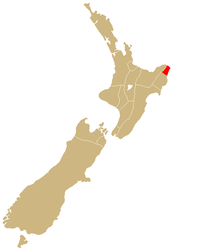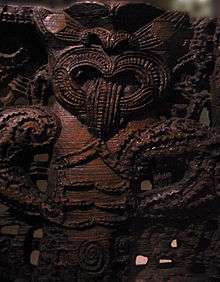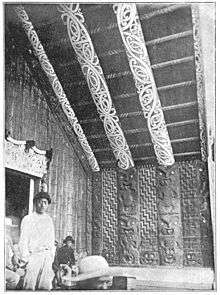Ngāti Porou
Ngāti Porou is a Māori iwi traditionally located in the East Cape and Gisborne regions of the North Island of New Zealand. Ngāti Porou is affiliated with the 28th Maori Battalion and has the second-largest affiliation of any iwi in New Zealand, with 71,910 registered members in 2006.[2] The traditional rohe or tribal area of Ngāti Porou extends from Pōtikirua and Lottin Point in the north to Te Toka-a-Taiau (a rock that used to sit in the mouth of Gisborne harbour) in the south.[3]
| Ngāti Porou | |
|---|---|
| Iwi (tribe) in Māoridom | |
 | |
| Rohe (region) | East Cape and Gisborne region |
| Waka (canoe) | Horouta |
| Population | 71,049[1] |
| Website | www |
Mt Hikurangi features prominently in Ngāti Porou traditions as a symbol of endurance and strength, and holds tapu status. In these traditions, Hikurangi is often personified. Ngāti Porou traditions indicate that Hikurangi was the first point to surface when Māui fished up the North Island from beneath the ocean. His canoe, the Nuku-tai-memeha, is said to have been wrecked there. The Waiapu River also features in Ngāti Porou traditions.[4][5]
History

Pre-European history
Ngāti Porou takes its name from the ancestor Porourangi, also known as Porou Ariki.[6] He was a direct descendant of Toi-kai-rākau. Other ancestors include Māui, accredited in oral tradition with raising the North Island from the sea, and Paikea, the whale rider.[4][5]
Although Ngāti Porou claim the Nukutaimemeha as their foundation canoe, many Ngāti Porou ancestors arrived on different canoes, including Horouta, Tākitimu and Tereanini. The descendants of Porourangi and Toi formed groups that spread across the East Cape through conquest and through strategic marriage alliances.[4][5]
Associations with other iwi also arise through direct descent from Ngāti Porou ancestors:
- Kahungunu, descending from Ueroa, second son of Porourangi, is the founding ancestor of Ngāti Kahungunu, who occupy the region south of the Ngāti Porou tribal boundaries.
- Taua, descended from Kahungunu, is a prominent ancestor in Te Whānau-ā-Apanui genealogy.
- Ngāti Raukawa and the Tainui iwi have association through Rongomaianiwaniwa, daughter of Porourangi, and the marriage of the ancestress Māhinaarangi to Tūrongo.
- Ngāi Tahu traditions also indicate descent from both Porourangi and from Tahupōtiki, younger-brother to the former.[4][5]
Colonial history
The early 19th century saw Ngāti Porou in conflict with Ngā Puhi during the latter's campaign of warfare throughout the North Island. This period also saw the introduction of Christianity to the region, which led to a period of relative calm and cultural development. Ngāti Porou chiefs were also signatories to the Treaty of Waitangi in 1840. Ngāti Porou experienced substantial economic growth during the 1850s.[4][5]
During the 1860s, the Pai Mārire religious movement spread through the North Island, and eventually came into conflict with the New Zealand Government. From 1865–1870, a civil war emerged within Ngāti Porou, between Pai Mārire converts seeking the creation of an independent Māori state (supported by Pai Mārire from other regions) and other Ngāti Porou advocating tribal sovereignty and independence. This conflict is generally viewed as part of the East Cape War.[4][5]
Modern history
Ngāti Porou once again enjoyed peace and economic prosperity during the late 19th century. The 1890s saw the emergence of Sir Āpirana Ngata, who contributed greatly to the revitalisation of the Māori people. During the early 20th century, the population of Ngāti Porou increased substantially. They were active in their participation in both World Wars.[4][5]
After World War II, large numbers of Ngāti Porou began emigrating from traditional tribal lands and moving into larger urban areas, in a trend reflected throughout New Zealand. A large portion of the tribal population now lives in Auckland and Wellington.[4][5]
Hapū and marae
Potikirua ki Waiapu
The Potikirua ki Waiapu rohe includes these hapū:
- Ngāi Tamakoro, of Tutua marae in Te Araroa
- Ngāi Tāne, of Hinepare marae in Rangitukia, and Ōhinewaiapu marae in Rangitukia
- Ngāti Hokopū, of Hinepare marae in Rangitukia, and Ōhinewaiapu marae in Rangitukia
- Ngāti Kahu, of Punaruku marae in Hicks Bay
- Ngāti Nua, of Hinepare maraein Rangitukia, and Ōhinewaiapu marae in Rangitukia
- Ngāti Putaanga of Kaiwaka marae in Tikitiki, and Putaanga marae in Tikitiki
- Ngāti Tuere of Hinemaurea ki Wharekahika marae in Hicks Bay, Hinerupe marae in Te Araroa, and Tutua marae in Te Araroa
- Te Whānau a Hinepare, of Hinepare marae in Rangitukia, Awatere marae in Te Araroa, Hinerupe marae in Te Araroa, Hurae marae in Te Araroa, Kaiwaka marae in Tikitiki, and Rāhui marae in North Tikitiki
- Te Whānau a Hunaara, of Matahī o Te Tau marae in Horoera, and Ōhinewaiapu marae in Rangitukia
- Te Whānau a Karuai, of Hinerupe marae in Te Araroa, Karuai marae in Tikitiki, and Waiomatatini marae in Ruatoria
- Te Whānau a Rākaimataura, of Rāhui marae in North Tikitiki
- Te Whānau a Rerewa, of Hinepare marae in Rangitukia, and Ōhinewaiapu marae in Rangitukia
- Te Whānau a Takimoana, of Ōhinewaiapu marae in Rangitukia
- Te Whānau a Tapuaeururangi, of Pōtaka marae in Pōtaka
- Te Whānau a Tapuhi, of Taumata o Tapuhi in Rangitukia
- Te Whānau a Te Aotakī Hinemaurea ki Wharekahika, of Tūwhakairiora in Hicks Bay
- Te Whānau a Te Uruahi Tinatoka, of Te Poho o Tinatoka in Tikitiki
- Te Whanau a Tinatoka Tinatoka, of Te Poho o Tinatoka in Tikitiki
- Te Whānau a Tuwhakairiora, of Hinemaurea ki Wharekahika marae in Hicks Bay, and Hinerupe marae in Te Araroa[3]
Waiapu ki Tawhiti
The Waiapu ki Tawhiti rohe includes these hapū:
- Ngāi Taharora Taharora, of Taharora marae in Waipiro Bay
- Ngāi Tangihaere, of Kariaka marae in Ruatoria, Ruataupare marae in Ruatoria, and Whareponga marae in Ruatoria
- Ngāti Horowai, of Te Horo marae in Port Awanui
- Ngāti Rangi, of Reporua marae in Ruatoria
- Ngāti Uepōhatu, of Mangahanea marae in Ruatoria, Uepōhatu marae in Ruatoria, and Umuariki marae in Tūpāroa
- Te Aitanga a Materoa, of Hiruhārama marae, Penu marae in Makarika, Rongohaere marae in Ruatoria, and Whareponga marae in Ruatoria
- Te Aowera, of Hiruhārama marae, and Te Aowera marae in Ruatoria
- Te Whānau a Hineauta, of Tikapa marae
- Te Whānau a Hinekehu, of Kariaka marae and Rauru marae in Ruatoria
- Te Whānau a Hinetapora, of Mangahanea marae in Ruatoria, and Te Heapera marae in Ruatoria
- Te Whānau a Iritekura Iritekura, of Iritekura marae in Waipiro Bay
- Te Whānau a Mahaki, of Te Horo marae in Port Awanui
- Te Whānau a Pōkai, of Tikapa marae
- Te Whānau a Rākaihoea Kākāriki, of Rākaihoea marae in Waiomatatini
- Te Whānau a Rākairoa, of Akuaku, Kie Kie marae in Waipiro Bay, and Rongohaere marae in Ruatoria
- Te Whānau a Te Haemata, of Kie Kie marae in Waipiro Bay
- Te Whanau a Ruataupare ki Tuparoa
- Te Whānau a Umuariki, of Umuariki marae in Tūpāroa
- Te Whānau a Uruhonea, of Te Horo marae in Port Awanui[3]
Tawhiti ki Rototahe
The Tawhiti ki Rototahe rohe includes these hapū:
- Ngāi Tutekohi Hauiti, of Ruakapanga marae in Tolaga Bay
- Ngāti Hau, of Hinetamatea marae in Anaura Bay
- Ngāti Ira, of Ōkurī marae in Tolaga Bay, and Tuatini marae in Tokomaru Bay
- Ngāti Kahukuranui, of Hauiti marae, Hinemaurea ki Mangatuna marae and Ōkurī marae in Tolaga Bay
- Ngāti Patu Whare, of Te Rawheoro marae in Tolaga Bay
- Ngāti Wakarara, of Hinetamatea marae in Tokomaru Bay
- Te Aitanga a Hauiti, of Hauiti marae and Te Rawheoro marae in Tolaga Bay
- Te Whānau a Ruataupare ki Tokomaru, of Pakirikiri marae, Tuatini marae and Waiparapara marae in Tokomaru Bay
- Te Whānau a Te Aotawarirangi, of Te Ariuru marae in Tokomaru Bay
- Te Whānau a Te Rangipureora, of Puketawai marae in Tolaga Bay[3]
Rototahe ki Te Toka a Taiau
The Rototahe ki Te Toka a Taiau rohe includes these hapū:
- Ngāti Konohi, of Te Poho o Rawiri marae in Kaitī, and Whāngārā marae
- Ngāti Oneone, of Te Poho o Rawiri marae in Kaitī[3]
Governance
Te Rūnanga o Ngāti Porou was established in 1987 to be the tribal authority of the iwi. It is organised into a whānau and hapū development branch, economic development branch, and a corporate services branch, and aims to maintain the financial, physical and spiritual assets of the tribe.[8] The common law trust is overseen by a board, with two representatives from each of the seven ancestral zones. As of 2018, the trust is based in Gisborne, and is chaired by Selwyn Parata, with Herewini Te Koha as both chief executive and general manager.[3]
The trust administers Treaty of Waitangi settlements under the Ngati Porou Claims Settlement Act, represents the iwi under the Māori Fisheries Act, and is the official iwi authority for resource consent consultation under the Resource Management Act. Its rohe is contained within the territory of Gisborne District Council, which is both a regional and district council.[3]
Media
Notable people
- Sir Āpirana Ngata
- Alex Aiono, singer
- William Singe, singer
- George Nepia
- Te Moana Nui a Kiwa Ngarimu VC
- Witi Ihimaera, writer
- Parekura Horomia politician
- John Tamihere, politician
- Moana Jackson
- Mokena Kohere
- Henare Mokena Kohere
- Reweti Tuhorouta Kohere, Anglican minister
- Mohi Turei, Anglican minister
- Sofia Minson, artist
- Wynton Rufer Sportsman
- Georgina Beyer, politician
- Robyn Kahukiwa
- Te Ngahuru, 28th Maori Battalion
- Dame Iritana Tāwhiwhirangi, educationalist
- Rory Fallon, Sportsman
References
- "2013 Census iwi individual profiles: Ngāti Porou". www.stats.govt.nz. Stats NZ. Retrieved 13 June 2017.
- "2006 Census – QuickStats About Māori (revised)". Statistics New Zealand. 2007-04-04. Archived from the original on 2007-09-28. Retrieved 2007-05-25.
- "TKM Ngāti Porou". tkm.govt.nz. Te Puni Kōkiri, New Zealand Government. Retrieved 2 March 2016.
- Mahuika AT (1993-05-25). "History: Porourangi & Ngāti Porou". Te Rūnanga o Ngāti Porou. Archived from the original on 2006-12-11. Retrieved 2007-04-10.
- Reedy, Tamati Muturangi (2006-12-21). "Ngāti Porou". Te Ara – the Encyclopedia of New Zealand. Archived from the original on 2007-04-30. Retrieved 2007-04-10.
- Ngata, Apirana Turupa; Te Hurinui, Pei (1970). Nga moteatea: he maramara rere no nga waka maha, he mea kohikohi na A.T. Ngata; na Pei Te Hurinui i whakapakeha. 3. The Polynesian Society. p. 323. Retrieved 2015-05-26.
That line traces out to Porou-rangi, whose (original?) name was Porou-ariki te mata-tara-a-whare, and Te Tuhi-marei-kura of Rauru.
- Reedy, Tamati Muturangi (24 September 2011). "Ngāti Porou: Porourangi whare, Waiomatatini". Te Ara - the Encyclopedia of New Zealand. Wellington, New Zealand: Manatū Taonga | Ministry for Culture and Heritage. Retrieved 12 May 2012.
- "Te Rūnanga o Ngāti Porou mission statement". Archived from the original on 2008-01-17. Retrieved 2007-05-17.
- "Radio Ngati Porou". Radio Ngati Porou. RNP. Retrieved 14 June 2015.
- "Iwi Radio Coverage" (PDF). maorimedia.co.nz. Māori Media Network. 2007. Retrieved 14 June 2015.
